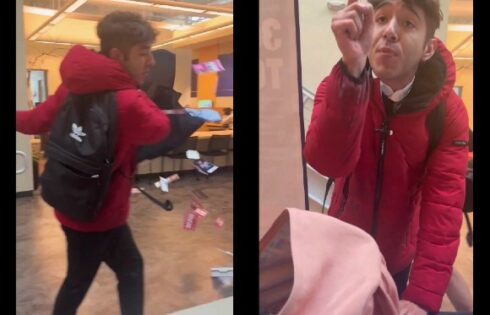
Fixes a transparency problem in the Violence Against Women Act
The Department of Education’s proposed Title IX regulation for sexual misconduct proceedings, released Friday, drew applause from a civil liberties group and lawyers familiar with such proceedings.
The Foundation for Individual Rights in Education, which sued the Obama administration for unlawfully imposing its nonbinding Title IX guidance, said the proposed regulation was “groundbreaking” for its departure from Obama-era provisions.
The requirement that proceedings include a live hearing “ensures that all parties can see exactly the same evidence and testimony that the fact-finder is seeing, so that he or she can rebut that evidence and testimony as fully as he or she is able,” wrote Susan Kruth, senior program manager for legal and public advocacy.
The cross-examination mandate is also more narrow than critics claim: Students don’t get to grill each other, they must be given advisors if they don’t bring their own, and they can be “questioned from a separate room” as long as the questioner and fact-finders can “simultaneously see and hear” the party testifying.
“It also implicitly recognizes that determining the credibility of witness testimony is a nuanced process that requires fact-finders to watch as well as listen,” Kruth continued.
It’s significant that the regulation includes the right of parties to see all evidence the college has collected. The Violence Against Women Act regulations, by contrast, only give students access to the evidence the college plans to use to support its case, Kruth said: “Of course, this would be unlikely to include any exculpatory evidence.”
MORE: Accused law student sues to end Obama’s ‘unlawful’ investigations
The mandate that evidence standards must be the same for both students and faculty – the latter often have higher standards – also reflects the seriousness of the consequences facing many accused students.
The “preponderance” standard, known casually as “more likely than not,” is particularly unsuited “for cases in which a student could be expelled and effectively have his or her educational career derailed,” especially when colleges “typically lack other safeguards against erroneous guilty findings,” Kruth said.
FIRE is particularly pleased that sexual harassment standards would be brought back in line with Supreme Court precedent.
“Overbroad harassment codes remain the most common type of speech code FIRE sees on college campuses,” a trend accelerated by the Obama administration when it told colleges that sexual harassment was “any unwelcome conduct of a sexual nature,” including speech, Kruth said.
The new “severe, pervasive, and objectively offensive” standard – taken directly from the Supreme Court’s Davis ruling – “would require policy changes at hundreds, if not thousands, of colleges and universities across the country,” she continued, a “sea change” on First Amendment rights for students.
The new proposed Title IX regulations feature essential safeguards for free speech and due process on campus.
We explain some of them in-depth here:https://t.co/ddoXncy3H3
— FIRE (@TheFIREorg) November 16, 2018
Consistency is more important than ‘choices’ for colleges
Kimberly Lau, who leads the college discipline practice at Warshaw Burstein, praised elements of the proposed regulation while saying it doesn’t go far enough to ensure consistency and fairness to both parties.
“Codifying the definition of sexual harassment and outlining specific requirements for what the process should look like will go a long way toward this goal,” she wrote in an email.
The Trump administration’s preference for “choices” in Title IX proceedings – namely, evidence standards and mediation opportunities – “may only yield inconsistent results across the country,” Lau said.
The preponderance standard, used in civil courts, “is applied in cases where the harm to society of an erroneous finding is approximately equal no matter whether the error favors the plaintiff or defendant”:
Clear and convincing evidence, as defined by our U.S. Supreme Court, means “highly probable” and is applied in cases where the risk of loss is relatively high, including depravations of individual rights. I would think schools should be required to determine it was “highly probable” that a student committed sexual assault, before that student is expelled.
MORE: Mandated cross-examination, same evidence standard for everyone
Mediation should also not be determined by whether the college wants it, Lau added. Many complainants in cases she has handled “are reluctant to move forward with the process and would rather arrive at an amicable resolution,” to the point where one such accuser won the case but appealed the harsh sanction on the accused student.
Lau praised the proposed ban on single-investigator models, which inhibit credibility determinations and prevent cross-examination, and noted it goes in line with court rulings across the country on the importance of cross-examination in Title IX.
“Gone are the days of one-line decisions finding a student ‘responsible'” without any explanation of the “rationale for all outcomes based on facts and evidence,” she added.
The importance of ‘and’ instead of ‘or’
Former Department of Education lawyer Hans Bader, who worked in the Office for Civil Rights in the George W. Bush administration, praised it for rejecting the “incredibly overbroad, unconstitutional definition of sexual harassment” the Obama administration released as a “blueprint” for colleges.
That definition would judge students sexual harassers for unsuccessfully asking someone out on a date, Bader wrote in an email.
Obama’s OCR also botched the Supreme Court’s three-prong definition of sexual harassment by rendering the “and” as “or,” meaning severe “or” pervasive “or” persistent behavior could be judged harassment:
Under harassment definitions echoing OCR’s past ‘severe OR pervasive’ definition, students have been accused of racial or sexual harassment on campus for criticizing affirmative action, feminism, and homosexuality, and for discussing things like the racial implications of the death penalty.
MORE: Leaked draft says bias against accused students violates Title IX
IMAGE: vchal/Shutterstock
Like The College Fix on Facebook / Follow us on Twitter






Please join the conversation about our stories on Facebook, Twitter, Instagram, Reddit, MeWe, Rumble, Gab, Minds and Gettr.